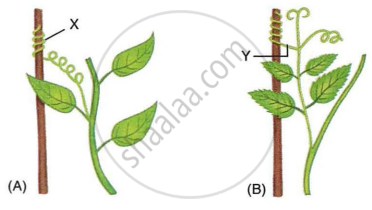Advertisements
Advertisements
प्रश्न
Distinguish between tropic movements and nastic movements in plants. Give examples to illustrate your answer.
How do tropisms differ from nasties (or nastic movements)?
उत्तर १
| Tropic movements | Nastic movements |
| These are directional movements of plants in response to stimulus. | These are non-directional movements of plants in response to stimulus. |
| Example: The upward growth of a plant stem in response to sunlight. | Example: The folding up of leaves in response to touch. |
उत्तर २
| Tropism | Nasties |
| Tropisms are the directional movement of plant parts in response to an external stimulus. | Nasties are the non-directional movements of plant parts in response to an external stimulus. |
APPEARS IN
संबंधित प्रश्न
What is the stimulus in chemotropism?
Name the plant part which bends in the direction of gravity but away from light.
A potted plant is kept horizontally for a considerable time. The three positions of the parts A and B of the potted plant are shown in the following figures:

- Which figure shows the correct position taken by the parts A and B of the plant?
- What type of phenomenon is exhibited by the figure chosen in (a) above?
How does phototropism occur in a plant stem (or shoot)? Explain with the help of labelled diagrams.
A potted plant is growing in a transparent glass jar. In this plant, X and Y are the two growing parts having a lot of meristematic tissue. It is observed that the part X of this plant exhibits positive geotropism but negative phototropism. On the other hand, part Y of this plant exhibits negative geotropism but positive phototropism.
(a) Name the part X of plant.
(b) Name the part Y of plant.
(c) Which part of the plant, X or Y, will exhibit positive hydrotropism?
(d) Which part of the plant, X or Y, can have tendrils on it?
(e) Which phytohormone causes the part X to exhibit negative phototropism?
When the leaves of a sensitive plant are touched with a finger, they fold up and when light fades at dusk, the petals of a dandelion flower close.
State one way in which the above two processes are similar.
Answer the following question.
What is tropism?
What is chlorophyll?
The instrument which can be used to demonstrate geotropism is ______.
Study the diagrams given below and answer the following questions:

- Name the structures shown as X and Y in the figures (A) and (B), respectively.
- Write the functions performed by the structures X and Y.
- Name the phenomenon depicted and define it.
- How do the structures X and Y differ from each other?
- Give examples of the plants which show the said phenomenon.
